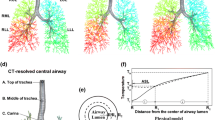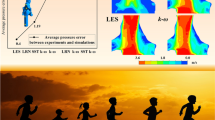Abstract
Both three-dimensional (3D) and one-dimensional (1D) computational fluid dynamics methods are applied to study regional water loss in three multi-detector row computed-tomography-based human airway models at the minute ventilations of 6, 15 and 30 L/min. The overall water losses predicted by both 3D and 1D models in the entire respiratory tract agree with available experimental measurements. However, 3D and 1D models reveal different regional water loss rate distributions due to the 3D secondary flows formed at bifurcations. The secondary flows cause local skewed temperature and humidity distributions on inspiration acting to elevate the local water loss rate; and the secondary flow at the carina tends to distribute more cold air to the lower lobes. As a result, the 3D model predicts that the water loss rate first increases with increasing airway generation, and then decreases as the air approaches saturation, while the 1D model predicts a monotonic decrease of water loss rate with increasing airway generation. Moreover, the 3D (or 1D) model predicts relatively higher water loss rates in lower (or upper) lobes. The regional water loss rate can be related to the non-dimensional wall shear stress (τ *) by the non-dimensional mass transfer coefficient (h *0 ) as \({h_0}^{*}= 1.15{\tau ^{*0.272}}, R = 0.842\).








Similar content being viewed by others
References
Bell, S. C., M. J. Saunders, J. S. Elborn, and D. J. Shale. Resting energy expenditure and oxygen cost of breathing in patients with cystic fibrosis. Thorax 51:126–131, 1996.
Boucher, R. C. Airway surface dehydration in cystic fibrosis: pathogenesis and therapy. Annu. Rev. Med. 58:157–170, 2007.
Burki, N. K. Ventilatory effects of doxapram in conscious human subjects. Chest 85:600–604, 1984.
Castro, M., S. B. Fain, E. A. Hoffman, D. S. Gierada, S. C. Erzurum, and S. Wenzel. Lung imaging in asthmatic patients: the picture is clearer. J. Allergy Clin. Immunol. 128:467–478, 2011.
Choi, S., E. A. Hoffman, S. E. Wenzel, M. H. Tawhai, Y. Yin, M. Castro, and C.-L. Lin. Registration-based assessment of regional lung function via volumetric CT images of normal subjects vs. severe asthmatics. J. Appl. Physiol. 115:730–742, 2013.
Daviskas, E., I. Gonda, and S. D. Anderson. Local airway heat and water vapour losses. Respir. Physiol. 84:115–132, 1991.
Feng, Y., C. Kleinstreuer, and A. Rostami. Evaporation and condensation of multicomponent electronic cigarette droplets and conventional cigarette smoke particles in an idealized G3–G6 triple bifurcating unit. J. Aerosol Sci. 80:58–74, 2015.
Ferron, G. A., B. Haider, and W. G. Kreyling. Inhalation of salt aerosol particles—i. Estimation of the temperature and relative humidity of the air in the human upper airways. J. Aerosol Sci. 19:343–363, 1988.
Freund, B. J., and A. J. Young. Environmental influence on body fluid balance during exercise: cold exposure. Massachusetts: US Army Research Institute of Environmental Medicine Natick, 1995.
Hasan, A. Understanding mechanical ventilation: a practical handbook. London: Springer, 2010.
Kays, W. M., and M. E. Crawford. Convective heat and mass transfer. New York: McGraw-Hill, 1993.
Kim, J. W., J. Xi, and X. A. Si. Dynamic growth and deposition of hygroscopic aerosols in the nasal airway of a 5-year-old child. Int. J. Numer. Methods Biomed. Eng. 29:17–39, 2013.
Lin, C.-L., M. H. Tawhai, and E. A. Hoffman. Multiscale image-based modeling and simulation of gas flow and particle transport in the human lungs. Wiley Interdiscip. Rev. Syst. Biol. Med. 5:643–655, 2013.
Lin, C.-L., M. H. Tawhai, G. McLennan, and E. A. Hoffman. Characteristics of the turbulent laryngeal jet and its effect on airflow in the human intra-thoracic airways. Respir. Physiol. Neurobiol. 157:295–309, 2007.
Lin, C., M. H. Tawhai, G. McLennan, and E. A. Hoffman. Computational fluid dynamics. IEEE Eng. Med. Biol. Mag. 28:25–33, 2009.
McFadden, E. R., B. M. Pichurko, H. F. Bowman, E. Ingenito, S. Burns, N. Dowling, and J. Solway. Thermal mapping of the airways in humans. J. Appl. Physiol. 58:564–570, 1985.
Morvay, Z., and D. Gvozdenac. Applied industrial energy and environmental management. Chichester: Wiley, 2008.
Miyawaki, S., M. H. Tawhai, E. A. Hoffman, and C.-L. Lin. A numerical study of correlation between aerosol deposition and airway skeleton of severe asthmatics. D52. Gas exchange in steady state, altitude, and exercise, San Diego: American Thoracic Society, 2014, pp. A6281–A6281.
Tabka, Z., A. B. Jebria, and H. Guénard. Effect of breathing dry warm air on respiratory water loss at rest and during exercise. Respir. Physiol. 67:115–125, 1987.
Tarran, R., B. Button, M. Picher, A. M. Paradiso, C. M. Ribeiro, E. R. Lazarowski, L. Zhang, P. L. Collins, R. J. Pickles, J. J. Fredberg, and R. C. Boucher. Normal and cystic fibrosis airway surface liquid homeostasis. The effects of phasic shear stress and viral infections. J. Biol. Chem. 280:35751–35759, 2005.
Tawhai, M. H., and P. J. Hunter. Modeling water vapor and heat transfer in the normal and the intubated airways. Ann. Biomed. Eng. 32:609–622, 2004.
Tawhai, M. H., P. Hunter, J. Tschirren, J. Reinhardt, G. McLennan, and E. A. Hoffman. CT-based geometry analysis and finite element models of the human and ovine bronchial tree. J. Appl. Physiol. 97:2310–2321, 2004.
Venegas, J. G., T. Winkler, G. Musch, M. F. Vidal Melo, D. Layfield, N. Tgavalekos, A. J. Fischman, R. J. Callahan, G. Bellani, and R. Scott Harris. Self-organized patchiness in asthma as a prelude to catastrophic shifts. Nature 434:777–782, 2005.
Vreman, A. W. An eddy-viscosity subgrid-scale model for turbulent shear flow: algebraic theory and applications. Phys. Fluids 16:3670, 2004.
Warren, N. J., E. J. Crampin, and M. H. Tawhai. The role of airway epithelium in replenishment of evaporated airway surface liquid from the human conducting airways. Ann. Biomed. Eng. 38:3535–3549, 2010.
Weibel, E. R. Morphometry of the human lung. New York: Academic Press, 1963.
Weiler, J. M., S. D. Anderson, C. Randolph, S. Bonini, T. J. Craig, D. S. Pearlman, K. W. Rundell, W. S. Silvers, W. W. Storms, D. I. Bernstein, J. Blessing-Moore, L. Cox, D. A. Khan, D. M. Lang, R. A. Nicklas, J. Oppenheimer, J. M. Portnoy, D. E. Schuller, S. L. Spector, S. A. Tilles, D. Wallace, W. Henderson, L. Schwartz, D. Kaufman, T. Nsouli, L. Schieken, and N. Rosario. Pathogenesis, prevalence, diagnosis, and management of exercise-induced bronchoconstriction: a practice parameter. Ann. Allergy. Asthma. Immunol. 105:S1–S47, 2010.
Wu, D., M. H. Tawhai, E. A. Hoffman, and C.-L. Lin. A numerical study of heat and water vapor transfer in MDCT-based human airway models. Ann. Biomed. Eng. 42:2117–2131, 2014.
Yin, Y., J. Choi, E. A. Hoffman, M. H. Tawhai, and C.-L. Lin. Simulation of pulmonary air flow with a subject-specific boundary condition. J. Biomech. 43:2159–2163, 2010.
Yin, Y., J. Choi, E. A. Hoffman, M. H. Tawhai, and C.-L. Lin. A multiscale MDCT image-based breathing lung model with time-varying regional ventilation. J. Comput. Phys. 244:168–192, 2013.
Acknowledgments
This work was supported in part by NIH Grants R01-HL094315, U01-HL114494, and S10-RR022421. We also thank SDSC, TACC, and XSEDE for the computer time.
Conflict of interest
E A. Hoffman is a shareholder in VIDA diagnostics, which is commercializing lung image analysis software derived from the University of Iowa lung imaging group.
Author information
Authors and Affiliations
Corresponding author
Additional information
Associate Editor John H. Linehan oversaw the review of this article.
Electronic supplementary material
Below is the link to the electronic supplementary material.
Rights and permissions
About this article
Cite this article
Wu, D., Miyawaki, S., Tawhai, M.H. et al. A Numerical Study of Water Loss Rate Distributions in MDCT-Based Human Airway Models. Ann Biomed Eng 43, 2708–2721 (2015). https://doi.org/10.1007/s10439-015-1318-3
Received:
Accepted:
Published:
Issue Date:
DOI: https://doi.org/10.1007/s10439-015-1318-3




